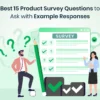Customer engagement and conversions are deeply connected to each other, but building a loyal customer base doesn’t happen overnight. There are numerous theories that estimate the base number of times a client should engage with your business brand before they step on to purchase a product from your brand.
While the real number of connections required is needed to be proven wrong, there is no doubt that customer engagement is important for moving prospects through your buying cycle.
Boost your customer engagement with proven strategies❤️
Discover how piHappiness can transform your approach today!
Through customer engagement strategies, brands can engage in every interaction with prospects as a chance to address their issues and expectations and at last increase client conversion rates.
What is a Customer Engagement Strategy?
A client engagement strategy sorts out communications and events into different strategies to create the best customer experience, including before and after the purchase.
This process includes various communication channels to build relationships, improve satisfaction, and manage your customer’s potential.
A successful strategy is one that is measured, what’s more, receptive to client needs, permitting you to gather feedback using a customer feedback app, and customer performance data necessary to support your strategy.
Advantages of Implementing Customer Engagement Strategy
Using a customer-centric approach gives your company a competitive edge in a world where customers have a lot of product options.
However, implementing a holistic customer engagement strategy will not only improve customer relations but will also be beneficial for businesses looking to increase conversions.
With an active customer base, companies may be able to see a lot of improvements across the company:
Improve Customer Experience
When customers are satisfied with your product or service, they are more likely to make a purchase, but this will not happen immediately.
Sometimes customers have to make the experience with your business brand often before they put in a request. Then again, it just takes one negative experience to beat clients down.
It is important to note that customer experience and customer engagement are sometimes used interchangeably, however, each one of them has different role in the cultivation process.
Client experience is the means by which shoppers see your brand, or how your brand is seen and gotten according to their viewpoint. Though, client commitment is the means by which the client interfaces with the experience and brand, including their choices and how they impart and respond to your products and services.
Improve the Quality of Customer Relationships
When false promises are made to customers, they will not make a purchase from a brand again anytime soon. They will not have a connection to your company, making your business brand only one of many options instead of giving it the first preference.
But when customers know and trust your business brand for providing them value, it will make a huge difference in their purchasing behavior.
Regardless of new trends, marketing campaigns, or competitors’ promises, customers can invest 23% in their trusted brands. Business is about relationships; relationships blossom with giving and take.
Client engagement permits you to move your focus from what you get from the customer to what you give them.
Increase the Likelihood of Referrals
At the point when clients have a fortunate or unfortunate experience with your brand, they will share it with others. So, when you exceed customers’ expectations, they likely will want their friends to experience the same. They would refer your business to their peers and loved ones, without your business being promoted.
What’s more, a decision-maker who is interested in your brand can become a lifelong customer, even if they start a career in a new company.
In the period of social media, particularly sites like Cry, Google, Facebook, and LinkedIn, allow people to publicly record their experiences with your business. Just like social media, a good review helps a lot, as 86% of people say they search for a business online preceding making a buy. Similarly, negative reviews can damage your business, and bad news spreads quickly, threatening to tarnish your reputation.
Approach Sales With Customer’s Point of View
Customer engagement requires you to put on your customer hat and approach sales and marketing from the customer’s point of view. The only way you can ensure that customers are satisfied is with the experience you can give them by asking what they want.
Through data collection (from your CRM, marketing platform, or marketing automation tools) and customer feedback and forums, creating an engagement plan includes both public listening and research such as brand promotion.
Some would say significantly more. The more you find out about your client, the better you can tailor your information and experience.
5 Proven Customer Engagement Strategies That Work
You should have an engagement strategy that will act all-in-one solution that aligns with your customer’s interests. While your methodology might contrast somewhat relying upon your sales team, client base, and product or service, there are
a few tried-and-true strategies to get you started:
Share Customer’s Your Company’s Story
Stories are memorable and relatable. They will give your clients motivation to have confidence in your business. You can create your brand with a message that defines your purpose, vision, and story.
Make your customers understand the “why” of the business. Make sure you include your customers in your story and give them a leading role: take the opportunity to get to know yourself, listen to their goals and frustrations, and create a common vision.
Give Your Customers Personalized Experiences
Customer experience generally falls into the realm of social media, email newsletters, and social sharing. You want that your clients should feel like they are important and not just one of many?
The key to making a well-designed personalized experience successful is to listen to your customers and provide a special touch that connects with them.
You can use data and customer research to gain insight into consumers and tailor customer interactions that appeal to them, focusing on cadence, process and how best to work.
Staring from personalized communications to customized online programs, create a personalized customer experience that lets consumers know you’re relevant to their needs and interests.
Listen Actively to Your Customers
Clients are exceptionally vocal about what they need, so listen to what they are trying to say. What are they talking about and not talking about your business? How are they comparing your business with your competitor’s business?
Make it easy for your customers to provide feedback, using any customer feedback software, share experiences, record feedback, and engage. A timely review will tell your audience that you heard what they had to say and are committed to improving the customer experience.
When you expect a negative response, make sure you listen to solve the problem, not just to appease the customer.
Offer Your Customers Helpful Content
Your customers are not buying products; they are buying solutions. It is unlikely that they will search for your product specifically as they are searching for a response to a common question or challenge.
Providing helpful authentic resources to meet these needs positions your business as a solution. Share content across all channels to reach every segment of your customers. Create videos, blogs, and social media sharing proven tips and practical tips that will help your customers.
Collaborate With Your Customers to Mutually Agree on a Plan
When planning a customer engagement strategy, make sure that it should be a collaborative effort, which must include input from the buyer and seller. A mutual action plan from both sides will identify the resources, achievements, and other data expected to satisfy client needs.
This approach takes the guesswork out of the process and makes the closing process quick and easy because customers can be sure that you will give them exactly what they want.






